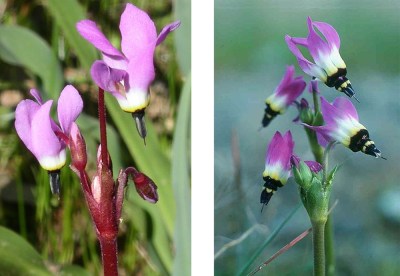
Mosquito Bills, Sailor Caps
Primula hendersonii
NATIVE
Description (Jepson, PlantID.net)
- Eudicotyledon
- Eudicots are a major lineage of flowering plants; see family for general characteristics
- Primrose Family (Primulaceae)
- Perennial herb; summer deciduous
- Primula species grow from rhizomes (horizontal underground stems); this species also grows from rice-like bulblets
- Leaves
- Simple (not divided into leaflets)
- Smooth or toothed margins
- Arranged in a basal rosette
- Nodding flowers (turned downwards) on a tall, red or purple scape (a leafless stem rising from ground level)
- 4-5 showy petals are swept backward
- Petal lobes are pink to lavender (rarely white), with a broad white band and narrow yellow and maroon bands at the base
- Pistil (female flower parts) and sharply-pointed, dark stamens (male flower parts) extend below the petals
- Ovary superior (above the attachment of other flower parts)
- Fruit is a many-seeded capsule (a dry, multi-chambered fruit that is dehiscent [splits open])
- Height 4-12 in.

Distribution
- Native to California
- Grows in a variety of habitats, including grasslands, foothill woodlands, and chaparral
- See Calflora for statewide observations of this plant
- Outside California, grows from southern British Columbia south into California and east into Idaho
- Grows at elevations to 6,235 ft.
Uses (San Mateo County Parks prohibits removal of any natural material)
- Wildlife
- Pollen source to bumble bees and other bee species
- Native people
- Flowers used decoratively and as a sleep aid
- Leaves used as an eye wash or oral gargle
- CAUTION – Leaves and roots can be eaten when roasted or boiled, but are poisonous when eaten raw

Name Derivation
- Primula (PRIM-oo-la) – from the Medieval Latin phrase prīmula vēris, “little first one of the spring,” referring to the plant’s early flowering
- hendersonii (hen-der-SONE-ee-eye) – named after Louis Fourniquet Henderson (1853-1942), whom the Native Plant Society of Oregon dubbed the “Grand Old Man of Northwest Botany”
- Shooting star – for the form of the flower
- The alternative common name mosquito bills refers to the narrow, sharp-pointed anthers
Notes
- Stamens (male flower parts) form an unusual structure: the anthers (pollen-producing parts) extend like fingers from a base of wide filaments (stalks) that fuse together to form a tube
- In a fresh flower, the elongated anthers form a cone around the pistil (female flower part), which extends beyond them
- Anthers are generally dark, but pollen-filled edges often appear lighter
- Flower turns upward following pollination
- Pollinated most effectively by sonication or “buzz pollination”; see Primrose family for details and buzz pollination video
- Plants germinated from seed may take 3-5 years to produce flowers (Schmidt 1980)

© TCorelli
ID Tips
- May be confused with padre’s shooting star (P. clevelandii var. patula)
- Henderson’s shooting star is more commonly found at Edgewood
- Purplish-red stem
- Filament tube, the fused, inflated stalks of the stamens (male flower parts), is slender and dark
- Anthers are long, tapered, and sharp-pointed
- Mature leaves usually roundish (elliptic to ovate) and smooth edged
- Padre’s shooting star is rarely seen at Edgewood
- Green stem
- Filament tube is stout and dark, with yellow spots creating a band (looks like a bumblebee!)
- Anthers are short and blunt-tipped
- Mature leaves usually more blade-like (oblanceolate) and wavy edged
- Henderson’s shooting star is more commonly found at Edgewood
- Jepson notes that shooting stars are highly variable and may hybridize
- Check out this short video (Jepson 2021a) for more ID tips on Edgewood’s shooting stars, and this second short video (Jepson 2021b) for ID tips on all of California’s shooting stars

At Edgewood
- Found in grasslands and woodlands
- See iNaturalist for observations of this plant
- Flowers February – April
Specific References
Jepson Herbarium. 2021a. Primula clevelandii (Cleveland’s shooting star) and Primula hendersonii (mosquito bills) [Video]. The Jepson Videos: Visual Guide to the Plants of California. The Regents of the University of California. YouTube.
Jepson Herbarium. 2021b. Primula (shooting stars) — Introduction & identification [Video]. The Jepson Videos: Visual Guide to the Plants of California. The Regents of the University of California. YouTube.
Schmidt, M. 1980. Growing Native California Plants. University of California Press, Berkeley, California. Pg. 104.
Wikipedia. 2018. Primula hendersonii. Wikipedia.org.
General References
Calflora Database. 2014. Berkeley, California.
Calscape. 2018. California Native Plant Society.
Charters, M.L. 2015. California Plant Names: Latin and Greek Meanings and Derivations.
Charters, M.L. 2017. Southern California Wildflowers: Guide to the Pronunciation of Specific, Generic and Family Names.
Corelli, T. 2004. Flowering Plants of Edgewood Natural Preserve (2nd. ed.). Monocot Press, Half Moon Bay, California.
Elpel, T.J. 2013. Botany in a Day: The Patterns Method of Plant Identification. HOPS Press, Pony, Montana.
Flora of North America. efloras.org.
Harris, J.G., and M.W. Harris. 2013. Plant Identification Terminology: An Illustrated Glossary. Spring Lake Publishing, Spring Lake, Utah.
Keator, G. 2009. California Plant Families. University of California Press, Berkeley and Los Angeles, California.
Native American Ethnobotany DB.
Regents of the University of California. Jepson eFlora. Jepson Herbarium. University of California, Berkeley.
